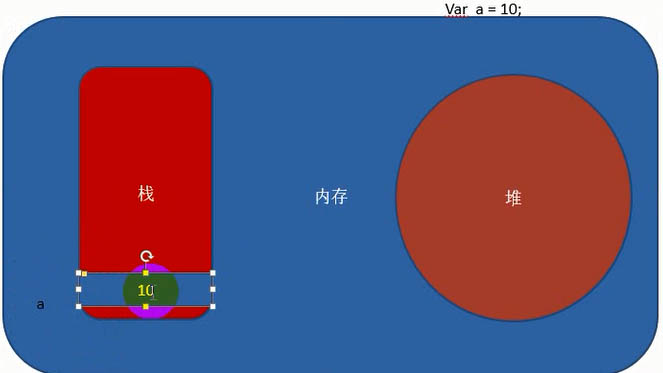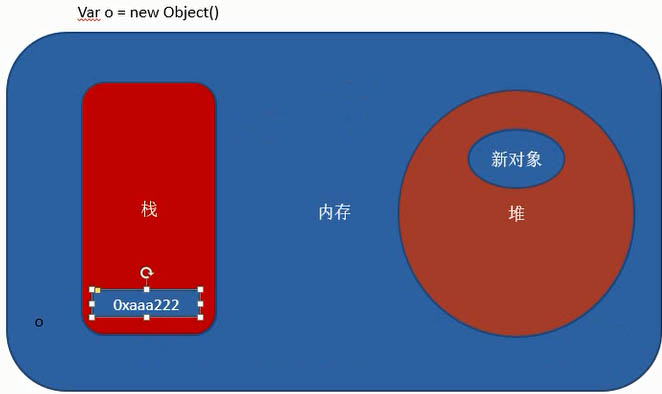JS basics essay (a must-read for newbies)
In the process of learning, places that I have swallowed up before will always appear again and again. Let’s record some of the knowledge points I learned today for future reference.
Data types in JavaScript
Simple (basic) data types: Number, String, Boolean, Undefined, Null
Complex (reference) data types: Object, Array, Date, function, etc.
The following is an introduction to the difference between simple (basic) data types and complex (reference) data types:
Simple data types: store values directly in the stack, as shown in the figure below

Complex data types: store references in the stack, as shown below

After understanding the above two data types After the storage method, you can distinguish the difference between the two by doing the following exercises:
var a =10; var b = a; //问:当改变a的值后,b的值是否发生改变 a=20; console.log(b); // 10
var s1 = new Object(); var s2 = s1; //问:改变s1的属性后,s2相同的属性是否改变 s1.name = "mh"; console.log(s2.name); //mh
function f2(arr)
{
arr = [9,8,7,6,5];//产生新的对象
arr[0]=-100;
}
var array = [1,2,4,7,5];
f2(array);
console.log(array[0]);// 1Variable promotion, function declaration and variable scope in JavaSript
First of all Look at the following interview question:
var num = 10;
fun();
function fun()
{
console.log(num);
var num =20;
}Before I learned it, I would have answered 10 directly. Now I am learning the concept of precompilation in JavaScript and I know the promotion concept of var keyword and function The concept of declaration knows that the above code is equivalent to the following code:
var num;//全局作用域 遇到var和function 提升
function fun() {
var num ; //局部做用户 遇到var 提升
console.log(num);
num =20;
}
num = 10;
fun();Look at the following question again:
//问题:为什么会出现下面的错误?
//Uncaught TypeError:fnName is not a function
console.log(fnName(1,2));
var fnName = function (a,b) {
return a + b;
}The above code is equivalent to The following code:
var fnName;
console.log(fnName(1,2));
fnName = function (a,b) {
return a + b;
}You can see that because function is on the right side of the equal sign, only var will be promoted, and the "Uncaught TypeError: fnName is not a function" error will be reported.
To understand the scope of variables, you can see the following code:
f1();
console.log(c);
console.log(b);
console.log(a);
function f1() {
var a = b = c = 20;
console.log(c);
console.log(b);
console.log(a);
}For continuous assignments such as var a=b=c=20;, only in the local scope Re-declare a, and the scope of b and c is the global scope. Therefore, only a in the global scope reports the error "Uncaught ReferenceError: a is not defined".
The above basic JS essay (a must-read for newbies) is all the content shared by the editor. I hope it can give you a reference, and I also hope that everyone will support the PHP Chinese website.
For more JS basic essays (a must-read for newbies), please pay attention to the PHP Chinese website!

Hot AI Tools

Undresser.AI Undress
AI-powered app for creating realistic nude photos

AI Clothes Remover
Online AI tool for removing clothes from photos.

Undress AI Tool
Undress images for free

Clothoff.io
AI clothes remover

Video Face Swap
Swap faces in any video effortlessly with our completely free AI face swap tool!

Hot Article

Hot Tools

Notepad++7.3.1
Easy-to-use and free code editor

SublimeText3 Chinese version
Chinese version, very easy to use

Zend Studio 13.0.1
Powerful PHP integrated development environment

Dreamweaver CS6
Visual web development tools

SublimeText3 Mac version
God-level code editing software (SublimeText3)

Hot Topics
 1655
1655
 14
14
 1414
1414
 52
52
 1307
1307
 25
25
 1254
1254
 29
29
 1228
1228
 24
24
 Demystifying JavaScript: What It Does and Why It Matters
Apr 09, 2025 am 12:07 AM
Demystifying JavaScript: What It Does and Why It Matters
Apr 09, 2025 am 12:07 AM
JavaScript is the cornerstone of modern web development, and its main functions include event-driven programming, dynamic content generation and asynchronous programming. 1) Event-driven programming allows web pages to change dynamically according to user operations. 2) Dynamic content generation allows page content to be adjusted according to conditions. 3) Asynchronous programming ensures that the user interface is not blocked. JavaScript is widely used in web interaction, single-page application and server-side development, greatly improving the flexibility of user experience and cross-platform development.
 The Evolution of JavaScript: Current Trends and Future Prospects
Apr 10, 2025 am 09:33 AM
The Evolution of JavaScript: Current Trends and Future Prospects
Apr 10, 2025 am 09:33 AM
The latest trends in JavaScript include the rise of TypeScript, the popularity of modern frameworks and libraries, and the application of WebAssembly. Future prospects cover more powerful type systems, the development of server-side JavaScript, the expansion of artificial intelligence and machine learning, and the potential of IoT and edge computing.
 JavaScript Engines: Comparing Implementations
Apr 13, 2025 am 12:05 AM
JavaScript Engines: Comparing Implementations
Apr 13, 2025 am 12:05 AM
Different JavaScript engines have different effects when parsing and executing JavaScript code, because the implementation principles and optimization strategies of each engine differ. 1. Lexical analysis: convert source code into lexical unit. 2. Grammar analysis: Generate an abstract syntax tree. 3. Optimization and compilation: Generate machine code through the JIT compiler. 4. Execute: Run the machine code. V8 engine optimizes through instant compilation and hidden class, SpiderMonkey uses a type inference system, resulting in different performance performance on the same code.
 JavaScript: Exploring the Versatility of a Web Language
Apr 11, 2025 am 12:01 AM
JavaScript: Exploring the Versatility of a Web Language
Apr 11, 2025 am 12:01 AM
JavaScript is the core language of modern web development and is widely used for its diversity and flexibility. 1) Front-end development: build dynamic web pages and single-page applications through DOM operations and modern frameworks (such as React, Vue.js, Angular). 2) Server-side development: Node.js uses a non-blocking I/O model to handle high concurrency and real-time applications. 3) Mobile and desktop application development: cross-platform development is realized through ReactNative and Electron to improve development efficiency.
 Python vs. JavaScript: The Learning Curve and Ease of Use
Apr 16, 2025 am 12:12 AM
Python vs. JavaScript: The Learning Curve and Ease of Use
Apr 16, 2025 am 12:12 AM
Python is more suitable for beginners, with a smooth learning curve and concise syntax; JavaScript is suitable for front-end development, with a steep learning curve and flexible syntax. 1. Python syntax is intuitive and suitable for data science and back-end development. 2. JavaScript is flexible and widely used in front-end and server-side programming.
 How to Build a Multi-Tenant SaaS Application with Next.js (Frontend Integration)
Apr 11, 2025 am 08:22 AM
How to Build a Multi-Tenant SaaS Application with Next.js (Frontend Integration)
Apr 11, 2025 am 08:22 AM
This article demonstrates frontend integration with a backend secured by Permit, building a functional EdTech SaaS application using Next.js. The frontend fetches user permissions to control UI visibility and ensures API requests adhere to role-base
 From C/C to JavaScript: How It All Works
Apr 14, 2025 am 12:05 AM
From C/C to JavaScript: How It All Works
Apr 14, 2025 am 12:05 AM
The shift from C/C to JavaScript requires adapting to dynamic typing, garbage collection and asynchronous programming. 1) C/C is a statically typed language that requires manual memory management, while JavaScript is dynamically typed and garbage collection is automatically processed. 2) C/C needs to be compiled into machine code, while JavaScript is an interpreted language. 3) JavaScript introduces concepts such as closures, prototype chains and Promise, which enhances flexibility and asynchronous programming capabilities.
 How do I install JavaScript?
Apr 05, 2025 am 12:16 AM
How do I install JavaScript?
Apr 05, 2025 am 12:16 AM
JavaScript does not require installation because it is already built into modern browsers. You just need a text editor and a browser to get started. 1) In the browser environment, run it by embedding the HTML file through tags. 2) In the Node.js environment, after downloading and installing Node.js, run the JavaScript file through the command line.




